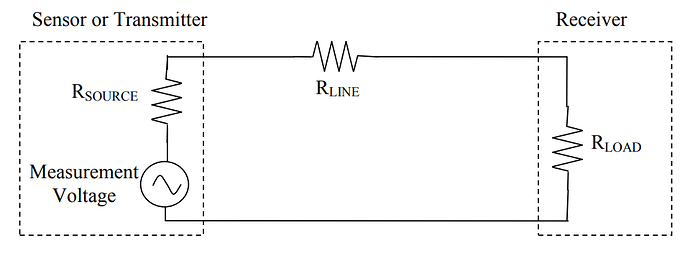Sensors like thermocouples, pH and ORP generate voltage signals directly. The direct voltage from the sensor, or after signal conditioning, is sent through the signal lines for measurement.
The accuracy of voltage measurement depends upon the nature of voltage source, its impedance, length of the wiring and the nature of receiving instruments used.
A typical voltage loop is shown in Fig.
Voltage Loop
RSOURCE is the internal impedance of the voltage source, the sensor or signal conditioner. The impedance of the signal lines is represented by the lumped component RLINE and RLOAD is the impedance offered by the receiver.
The sensor, line and receiver impedances form a voltage divider such that the voltage measured by the receiver is the measurement or source voltage minus the combined drop across RSOURCE and RLINE.
For this reason the input impedance of the receiver is made very high in comparison to the source and line resistances so that the current in the loop and hence the voltage drops across RSOURCE and RLINE become insignificant. So voltage-mode loops operate at very high impedances.
This makes the signal lines very susceptible to noises arising out of electric fields and ground potential differences. Electric fields may be generated from nearby natural or man-made sources.
The most common sources include power equipment and switching power supplies. Receiver design having high common-mode rejection ratio with appropriate filters makes the system immune to such noises.
Appropriate shielding of signal lines also decouples them from interfering sources. Signal conditioner at the sensing end may also be used to raise the level of the signal voltage for improving the signal to noise ratio.
Ground potential differences at site and at receiving ends often create measurement errors where sensors are tied to local grounds, for example, grounded thermocouples whose tips are welded to the inner surface of the protecting sheath to increase speed of response of the sensors.
The local ground may differ from the receiver ground by appreciable amount creating measurement inaccuracies. Signal isolation between site and receiver removes the problem but at an additional cost.
The main advantage of voltage signals, however, is that they can be multiplexed directly. The expensive signal conditioning and data conversion equipment can be shared with many loops. This reduces the per loop cost of these functions.
